Hi! I’m Kristin, a.k.a. The Shabby Bride, from BB Frösch. I’m all about furniture makeovers, up cycles, and redesigns. I’m the lady you see in public wearing comfy painty clothes, hair pulled back, no make-up, diet Dr. Pepper in hand, and looking, well, less than “put together.” When I say “in public,” I’m referring to Home Depot, Hobby Lobby, Garage Sales, and Auctions–not the grocery store. Truthfully, my hands are more comfortable wielding a paintbrush than a spatula.
I am so excited to share my all-time favorite, makes-you-feel-like-a-furniture-make-over-rock-star, “hand-painted” furniture hack!
Are you ready to go from this… 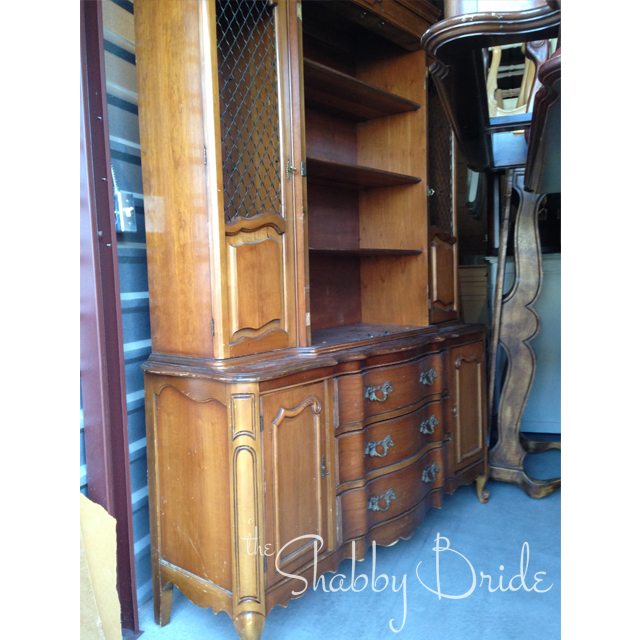
…to THIS? “Hand-painted” typography and all?
Let’s dive right in, so you can get to the business of impressing everyone you know with your mad new “hand-painted” furniture skills…
Step One: Start with a hand-me-down or garage sale-worthy piece of furniture. With chalk paint, you don’t need anything fancy, because, by the time you’re done, you will have created your own masterpiece. This lovely “rescue” hutch was missing a couple of doors, some glass, and a door pull. I needed a hutch for a store display–we were a match made in heaven.
Step Two: Pick a color, ANY color. Color selection usually takes me longer than actually painting a piece. Ever since I discovered BB Frösch Chalk Paint Powder, and I learned I could make chalk paint in ANY COLOR I wanted, the guy at the Home Depot paint counter (his name is Christian–we’re on a first-name basis) and I became fast friends. For this project, Christian mixed up a quart of Behr Premium Interior Flat paint to match the green pillows on my bed. You gotta love when you can make chalk paint to match your favorite pillows!
Step Three: With BB Frösch Chalk Paint Powder, you can choose to mix up as much or as little paint as you want. For this project, I went ahead and mixed the whole quart into chalk paint, even though I knew I would only need 10-12 oz. because, let’s face it, the color is awesome, and I knew I would use it again. How did I know I would need less than 1/2 quart? Because chalk paint has incredible coverage! Click here to see how easy it is to make your own chalk paint.
Step Four: Paint your piece. I painted two coats using “hashtag” strokes. Because chalk paint is self-leveling, painting cross hatches (or hashtags, for the more current among you) actually helps the top layer of paint “settle” into the bottom layer, which makes for a nice, smooth finish.
Step Five: Here’s where the MAGIC happens! Paint two or three pieces of paper. That’s right, take a few pieces of ordinary printer paper and paint them using the same “hashtag” strokes you used to paint your piece. I painted several pieces because I wanted “hand painted” typography on four separate doors. Let the paper dry.
Step Six: Once the paper is dry, iron the curled edges flat (painted side down.) I used my clothes iron. Don’t worry, my clothes iron doesn’t actually know it’s meant for clothes, so it didn’t squawk.
Step Seven: Select a graphic. I poured over the amazing graphics over at The Graphics Fairy before settling on these two:
Step Eight: Print your fancy images on your freshly-painted paper. That’s right, just run the painted (and dried, of course) paper through your printer. Trust me, your printer will be none the wiser!
Step Nine: To set the ink, spray a thin coat of Plastercraft Acrylic Gloss Spray Finish over the printed paper. You can find this handy stuff at Hobby Lobby or Michaels for a couple dollars. DON’T SKIP THIS STEP! There’s nothing worse than watching your lovely “hand painted” typography smear when you apply it because the printer ink wasn’t set!
Step Ten: Trim your image. I trim as close to the outside edge of the graphic as possible, but I don’t get too detailed with my scissors.
Step Eleven: Using a black sponge brush, spread a generous layer of Mod-Podge onto the back only of the painted paper, and place the paper onto your painted furniture surface.
Note to make Step Eleven easier: I waxed my hutch after painting, and before placing the image, but you don’t necessarily need to wax first. I think it’s easier to place the image if I can spritz a little water on the surface first to help move my image into place. You’ll want to get your image fairly close to it’s final resting place to avoid wrinkling. Carefully press any bubbles out to the edge of your image using the palm of your hand. Don’t rub the bubbles out–think more like a rolling pin motion. If necessary, dab a little extra Mod-Podge under any edges that aren’t totally glued down. DO NOT MOD-PODGE OVER THE TOP OF YOUR IMAGE! You will use the same finishing technique over your image that you use on the rest of your piece. See the next step to learn how I finished mine…
Step Twelve: Now that your graphic is part of your piece, finish it the same way you finish the rest of the piece. I chose to lightly distress then clear wax to seal and protect. I apply clear wax using a BB Frösch Wax Brush in a circular motion, then wipe excess wax with a lint-free cloth. If you want to age your piece with dark wax after clear waxing, like I did, age the painted piece of paper just as you age the whole piece.
VIOLÀ! Because your paper is painted with the exact same paint as your furniture piece, no one will ever know the image wasn’t painstakingly and delicately hand painted directly onto your furniture!
It can be our little secret…

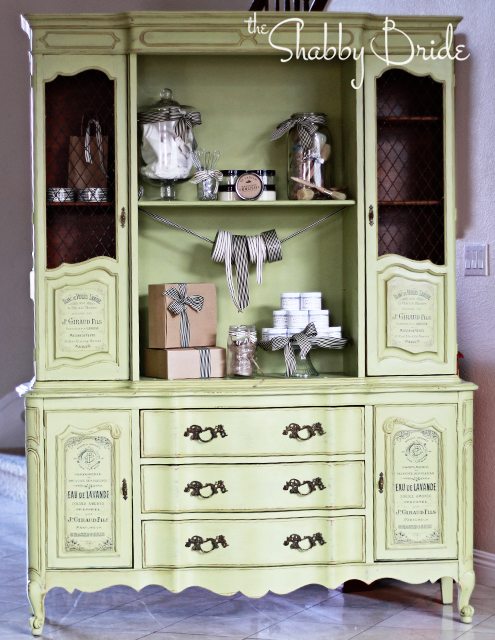
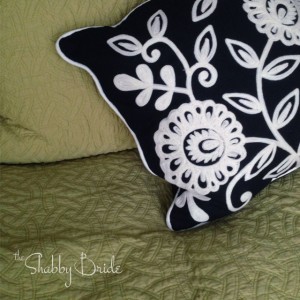
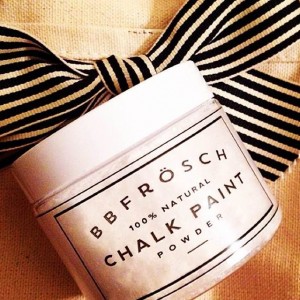
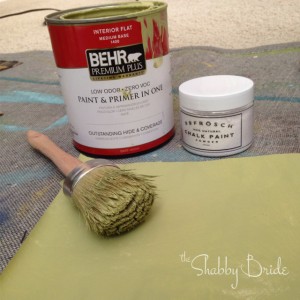
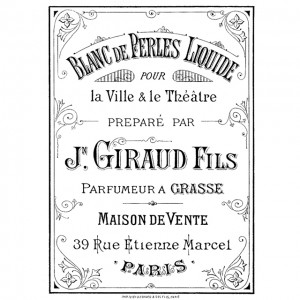
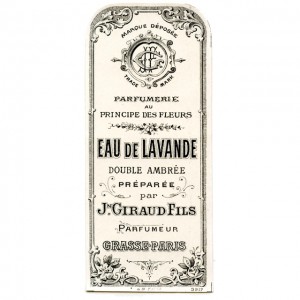
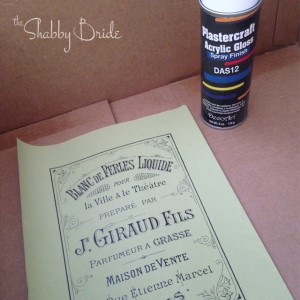
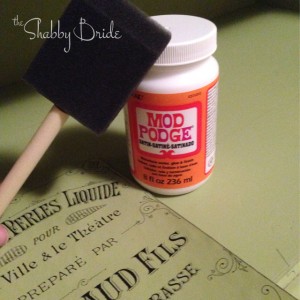
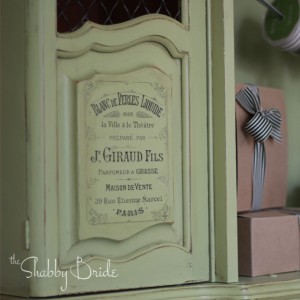
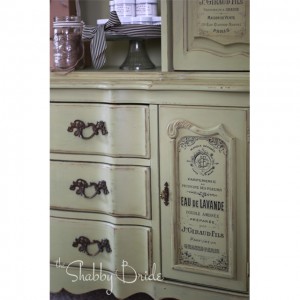
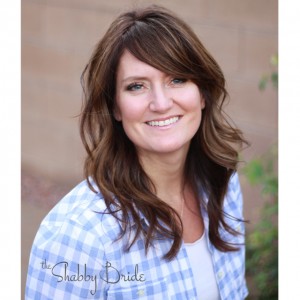
This is ingenious! I am going to have to remember that “hand-painted” trick!
This is GORGEOUS!!! OMG! Amazing – LOVE this piece! Thank you for the instructions!
This is an amazingly beautiful piece!! OMG LOVE this! Thank you for the instructions!
That looks awesome! My only question, and I’ve asked other bloggers, but can’t get a real answer, is why use wax over chalk paint? Why not just use flat paint, then wax, or a satin or eggshell finish paint?
I’ve made up chalk paint with the grout powder, but we use it for the kids to draw on, and our pantry list, so I guess I’m kind of confused about using it for non-writing-on purposes =/
Viv–
That’s a great question! Chalk paint (as opposed to just plain flat paint) has bonding agents that help it adhere to wood, metal, laminate, etc. WITHOUT having to sand, strip, or prime your piece first. Who has time to sand down, strip and prime your piece first?!? Flat paint (or satin, or eggshell, etc.) without a bonding agent (in this case, BB Frösch Chalk Paint Powder) will more or less “lay” on top of your piece without actually bonding to the surface. Think of peeling dripped paint off the edge of a paint can–that’s what regular latex paint will do with most surfaces. Blech!
The wax acts as a sealing and protecting agent for chalk paint. Wax can be left to appear more flat, but it can also be gently buffed to a sheen. Wax bonds with chalk paint for a clear, durable finish.
Latex paint mixed with un-sanded grout is NOT chalk paint! Although grout has some bonding properties, it is not intended for paint, can be harmful, is grainy, and hardens into a yucky mess! Comparing paint made with grout is like comparing apples to oranges. BB Frösch Chalk Paint Powder mixed with flat latex paint creates a creamy, smooth paint that bonds with virtually every surface, has excellent coverage (typically one or two coats less paint is needed), distresses like a dream (if a distressed look is what yore after,)and has endless possibilities for finishes. Although shabby chic, distressed and vintage looks are popular uses for chalk paint, you can also achieve smooth, sleek and modern finishes!
This is INCREDIBLE!!! Just ordered from your site. Can’t wait for my powder to arrive!! I do have a question. I have never waxed furniture, can you recommend a brand? Also, would you recommend priming before painting a shelf red (the thorn in my side color). Thank you so much!!! Lisa.
Lisa–
No need to prime first! Yay! I do recommend sealing with wax to protect and add durability. BB Frosch Wax is not yet available…stay tuned! Until then, I recommend Annie Sloan soft wax.
As someone who has painstakingly transferred over and then hand painted graphics (LOVE the Graphics Fairy!) onto furniture and home accent pieces, I could kiss you for this hack! It’s probably the single best hack I’ve ever read! If you had any idea how much I enjoy painting and artsy-ing up stuff, and you just may have an idea by now, you’d know that’s not an exaggeration. Thank you! Thank you!
Absolutely cannot wait to try this! Your are so smart and I love your finished piece!
Game. Changer!!!! Thank you so much for this! I have several pieces that I want to add graphics to but haven’t yet. Mostly because I don’t have the steady hand, or over head projector or who knows what all in order to complete the project. This is genius!!! Thank you!!
Love this! What kind of printer do you use? Ink jet or laser or other??
Cathie–
I use a regular ink jet printer (it cost about $100 at Costco.) The KEY is making sure you SET YOUR INK so it doesn’t bleed! Don’t forget the acrylic spray!
Super glad I found this!! LOVE!! However … I cannot seem to print without the graphics bleeding 🙁 Any tips??
Adriane–
I have never had an issue with the ink bleeding when it is printed. Make sure the ink is fully dry before doing anything with your graphic. Additionally, DO NOT FORGET to set the ink with an acrylic spray.
Your work is lovely! Thank you for sharing! Just wondering how long it takes for the paint to completely cure? I have painted furniture in the past and items placed on top of the finished and dried piece will stick and nick up the finish.